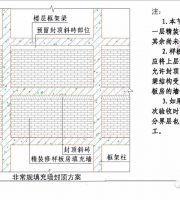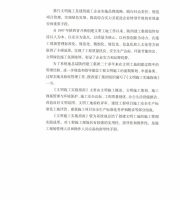From the above analysis, it can be seen that three problems are mainly solved in concrete construction in winter: 1) how to determine the shortest curing age of concrete; 2) How to prevent early freezing damage of concrete; 3) How to ensure that the later strength and durability of concrete meet the requirements? In the actual project, according to the air temperature during construction, the condition of engineering structure (engineering quantity, structural thickness and exposure), the urgency of construction period, the variety and price of cement, the performance and price of early strength agent, water reducer and antifreeze agent, the performance and price of thermal insulation materials, the conditions of heat source, etc, To choose a reasonable construction method.
The test results show that early strength Portland cement should be used..
If the concrete is maintained after thawing (i.e.
Therefore, the hydration slows down and the strength increases correspondingly slowly.
The experimental study also shows that the longer the pre curing period before freezing, the smaller the strength loss.
It can be seen that before the concrete is frozen, it should have a pre curing period at normal temperature to accelerate the hydration of cement and make the concrete obtain the minimum strength without freezing damage, which is generally called critical strength, so as to achieve the expected effect.
The exploration and Research on the theory and method of concrete construction in winter at home and abroad believe that when the ambient temperature drops below 5 ℃, as long as appropriate construction methods are adopted to avoid the early freezing of newly poured concrete and maintain a small temperature difference between the exposed concrete and the external temperature in winter, it will also achieve the effect of construction in warm weather.
The temperature continues to drop.
2.
Types of concrete construction methods in winter 1) the mix proportion adjustment method is mainly applicable to concrete construction at about 0 ℃.
For the concrete with short safe pre curing period and low initial strength, the later strength will change at any time.
When the water in the concrete completely turns into ice, that is, the complete liquid phase change into solid phase, the cement hydration basically stops, and the strength does not increase at this time.
After water turns into ice, the volume increases by about 9%, and an expansion stress of about 2500 kg / cm2 is generated.
Antifreeze can not fundamentally change the law of concrete strength growth at low temperature.
Source: the copyright of architecture belongs to the original author.
Influence of antifreeze content on concrete strength II.
For the long pre curing period, the concrete with high initial strength (e.g.
Early strength component in antifreeze: improve the early strength of concrete, make the concrete exceed the critical strength before water freezes, and reduce the impact of ice on concrete strength.
Harm of concrete frost damage: reduce concrete strength, cause concrete cracks, rust of reinforcement in concrete, reduce concrete durability, and prevent concrete frost damage.
Generally speaking, there can be several different winter construction schemes for the same project.
For the critical strength, the values specified by various countries vary.
35% of R28) has almost no loss of later strength after freezing.
3.
Air entraining component in antifreeze: uniform, stable and closed micro bubbles to reduce the pressure and volume change of concrete caused by the volume change caused by the process of water to ice.
Specific methods: ① selecting appropriate varieties of cement is an important means to improve the frost resistance of concrete.
The results show that the newly poured concrete has a pre curing period before freezing, which can increase its internal liquid phase, reduce solid phase and accelerate the hydration of cement.
An ideal scheme should use the shortest construction period and the lowest construction cost to obtain the best project quality, that is, the optimization of construction period, cost and quality.
General principles: reduce water consumption, improve early strength, reduce water freezing point, “buffer” ice pressure on internal structure of concrete, reduce concrete volume change, and action mechanism of concrete antifreeze: 1 Water reducing component in antifreeze: reduce water for concrete mixing and improve concrete strength; Reduce the content of free water in the concrete mixture to reduce the probability of freezing injury.
Concrete construction method in winter 1.
In addition, when water turns into ice, ice with large particles will be generated on the surface of aggregate and reinforcement, weakening the adhesion between cement slurry and aggregate and reinforcement, thus affecting the compressive strength of concrete.
Many scholars at home and abroad have carried out a large number of tests on the form of water in concrete.
China stipulates that it shall not be less than 30% of the design grade, nor less than 35 kg / cm2.
It can be seen that in winter concrete construction, the change of water form is the key to the growth of concrete strength.
This stress value is often greater than the initial strength value formed inside the cement stone, which makes the concrete receive different degrees of damage (i.e.
Many places in China have long cold seasons.
Provisions on limited service temperature of antifreeze: effective action temperature of antifreeze; actual “effective action temperature” of Antifreeze on concrete structure; provisions on applicable temperature of antifreeze; action of concrete antifreeze: antifreeze rapidly improves early strength.
The speed of cement hydration is mainly changed with the temperature, except that it is related to the constituent materials and mix proportion of concrete itself.
When the ice melts, various voids will be formed in the concrete, which will reduce the compactness and durability of the concrete.
under normal temperature conditions), its strength will increase, but the increase range is different.
Selection of concrete construction method in winter.
1、 General principle of concrete engineering construction in winter the reason why the concrete mixture gradually sets and hardens after pouring until the final strength is obtained is the result of cement hydration.
early freezing damage) and reduce the strength.
At present, the following four methods are basically adopted.
When the temperature rises, the hydration is accelerated and the strength of the solution increases rapidly; When the temperature drops to 0 ℃, part of the water in the concrete begins to freeze and gradually changes from liquid phase (water) to solid phase (ice).
At this time, the water involved in cement hydration is reduced.
With the rapid development of construction engineering, due to the restriction of construction period, the concrete construction of many projects in winter is inevitable.
2.


